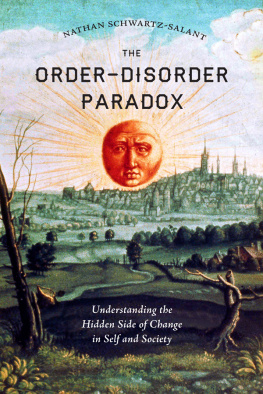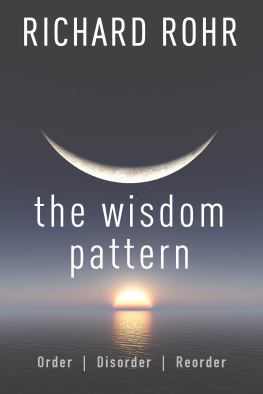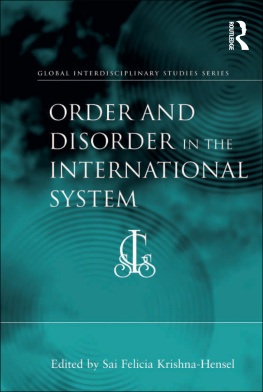
Praise for The Order-Disorder Paradox
This brilliant, wise, and profound book is a masterwork by one of the worlds leading psychologists. Drawing on a vast array of sources and a lifetimes experience, Nathan Schwartz-Salant reveals a great truth hidden at the heart of the worlds authentic mystical traditions: that all new order also creates disorder. This extraordinary work is a must-read for all those who want to understand the rhythms of life and the meanings of our contemporary chaos.
Andrew Harvey, author of The Hope: A Guide to Sacred Activism
The Order-Disorder Paradox is the result of five decades of devoted investigation in the domains of mathematics, engineering, psychology, and mysticism. It is not only a cogent, elegant, and highly original theory but also an eminently practical way to understand the seemingly unpredictable oscillations of psychological healing and personal transformation. This book calls for powerful and immediate shifts in how we approach the clinical encounter as well as the life of the soul.
Lorie Eve Dechar, author of Five Spirits: Alchemical Acupuncture for Psychological and Spiritual Healing
Schwartz-Salant offers a far-reaching and profound exploration of the dialectical interplay between order and disorder. Moving beyond the contemporary rationalist worldview that seeks to repress disorder in favor of order, he points us to a trans-rational alternative well suited to our tumultuous timesan alternative that, in harking back to our pre-rational origins in myth, does not merely regress to those origins but carries us forward into new territory. The Order-Disorder Paradox is a highly significant, compelling work that deserves the rapt attention of theorists, psychoanalysts, and laypeople alike.
Steven Rosen, Emeritus Professor of Psychology, College of Staten Island, City University of New York; author of Dreams, Death, Rebirth
This long-awaited book comes at just the right timenot only for psychotherapists, who will benefit greatly from its clinical insights, but also for scholars of politics and culture. This is a deeply thought-out work, the fruit of many years of reflection and patient observation.
Murray Stein, PhD, author of Soul: Treatment and Recovery
Copyright
Copyright 2017 by Nathan Schwartz-Salant. All rights reserved. No portion of this book, except for brief review, may be reproduced, stored in a retrieval system, or transmitted in any form or by any meanselectronic, mechanical, photocopying, recording, or otherwisewithout the written permission of the publisher. For information contact North Atlantic Books.
Published by
North Atlantic Books
Berkeley, California
Cover art from Splendor Solis (1582), an illuminated alchemical manuscript in the Harley Collection at the British Library (Harley 3469, f.33v); public domain. Available from the British Library online at http://www.bl.uk/catalogues/illuminatedmanuscripts/ILLUMIN.ASP?Size=mid&IllID=28031
Cover design by Howie Severson
Interior design by Happenstance Type-O-Rama
Printed in the United States of America
The Order-Disorder Paradox: Understanding the Hidden Side of Change in Self and Society is sponsored and published by the Society for the Study of Native Arts and Sciences (dba North Atlantic Books), an educational nonprofit based in Berkeley, California, that collaborates with partners to develop cross-cultural perspectives, nurture holistic views of art, science, the humanities, and healing, and seed personal and global transformation by publishing work on the relationship of body, spirit, and nature.
North Atlantic Books publications are available through most bookstores. For further information, visit our website at www.northatlanticbooks.com or call 800-733-3000.
Library of Congress Cataloging-in-Publication Data
Names: Schwartz-Salant, Nathan, 1938 author.
Title: The order-disorder paradox : understanding the hidden side of change
in self and society / Nathan Schwartz-Salant.
Description: Berkeley, California : North Atlantic Books, [2016] | Includes
bibliographical references and index.
Identifiers: LCCN 2016029016 | ISBN 9781623171162 (trade paper)
Subjects: LCSH: Psychic energy (Psychoanalysis) | Self. | Psychotherapy.
Classification: LCC BF175.5.P72 S39 2016 | DDC 150.19/5dc23
LC record available at https://lccn.loc.gov/2016029016
1 2 3 4 5 6 7 8 9 Sheridan 21 20 19 18 17
Printed on recycled paper
North Atlantic Books is committed to the protection of our environment. We partner with FSC-certified printers using soy-based inks and print on recycled paper whenever possible.
Acknowledgments
In a marriage, each person is challenged to absorb and contain some of the disorder of the others creative endeavors. When they choose to travel this path together, dealing with the protean nature of the psyche stirred up along the way, they can build a precious vessel for an ever-unfolding relationship.
I have not only been accompanied by my wife, Lydia, on this path, but I have also benefited from her involvement in the ideas that are presented here as The Order-Disorder Paradox. Her encouragement, unflagging interest, and insights have been a major driving force over the time it has taken me to write this book. It is a work that is our combined effort, a product of the conjoined field we have created.
I would also like to express gratitude to my patients for the courage they displayed in their suffering through the endless permutations of the Order-Disorder Paradox phenomenon in their lives, and for trusting me with the care and beauty of their individual souls. And my gratitude as well goes to my editor, Pamela Johnson, for her remarkable editorial skills, her profound care, and her intelligence in making sense of some of my more inscrutable passages. I would also like to express my appreciation to North Atlantic Books for the high quality of their publishing effort, and especially to Erin Wiegand for her care in guiding this book into production.
Introduction:
Discovering the Order-Disorder Paradox

In 1966 I was twenty-eight years old and began training to become an analyst at the C. G. Jung Institute in Zrich, Switzerland. As a consequence of a mystical vision of Light that I had experienced two years before, and after completing my PhD in Engineering Sciences, a field akin to applied mathematics, I had chosen not to pursue a career in science. The mystical experience and my scientific background bear on the discovery of what I eventually called the Order-Disorder Paradox (ODP): increasing order in a psychic system creates disorder. They also caused years of reluctance to publish this work.
The Light experience, or unio mystica, occurred when I had passed my qualifying exams and could finally see a clear path toward a doctorate. Up to that point, all meaning for me was tied to a somewhat compulsive pursuit of that degree in science. However, as my goal neared reality, a gloomy thought was irrepressible: I could neither see myself teaching science at a university, nor see myself beginning a career in industry. I had forged ahead on a path I never questioned, but now this quest seemed meaningless. I felt the bottom had suddenly dropped out of my existence.
It was early fall, 1964. At my apartment in Berkeley, California, the day after this awareness, and still stunned by it, I happened to listen to KPFA, a public radio program, and heard Harvard professor Timothy Leary speaking about the wonders of a new hallucinogenic drug, LSD. By coincidence, within twenty-four hours a friend arrived at my apartment with the drug, which he had just brought back from the East Coast. Several days later, alone, I took 100 micrograms of LSD, and the result was a vision of Light that was life changing.
Next page








